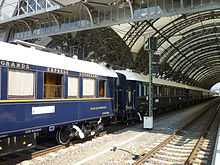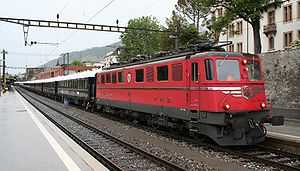Venice-Simplon Orient Express
 | |
 | |
| Info | |
|---|---|
| Franchise(s): | Railtour Operator |
| Main service(s): |
Venice Simplon-Orient-Express British Pullman Northern Belle Royal Scotsman Eastern & Oriental Express Perurail |
| Other service(s): |
Orient-Express Hotels Afloat in France Road to Mandalay |
| Fleet size: | 17 rail carriages (restaurant, Pullman) |
| Parent company: | Orient-Express Hotels Ltd |
| Web site: | www.vsoe.com |
The Venice Simplon-Orient-Express, or VSOE, is a private luxury train service from London to Venice that is popularly referred to as the Orient Express, its historic namesake.
The original company was founded by James Sherwood of Kentucky, USA, in 1982; five years earlier, in 1977, he had bought two of the original carriages at an auction when the Compagnie Internationale des Wagons-Lits withdrew from the Orient Express service, passing the service on to the national railways of France, Germany, and Austria. Over the next few years, Sherwood spent a total of US$16 million purchasing 35 sleeper, restaurant and Pullman carriages. On 25 May 1982, the first London–Venice run was made.
It is currently owned by Orient-Express Hotels Ltd. The company owns 50 luxury hotels, restaurants, tourist trains and river cruises in 24 countries.
Today
VSOE runs services today to eight major destinations in Europe between March and November:
- London
- Paris
- Rome
- Venice
- Vienna
- Prague
- Budapest
- Bucharest
- Istanbul
- Dresden
- Kraków
- Stockholm
- Copenhagen
The VSOE has separate carriages for use in the UK and for continental Europe, but all of the same vintage (mostly dating from the 1920s and 1930s). Passengers are conveyed across the English Channel by coach on the Eurotunnel shuttle through the Channel Tunnel. Whereas restored Pullman carriages are used in the UK, in continental Europe restored dark blue former Compagnie Internationale des Wagons-Lits carriages are used. Note that the service in the UK is called the British Pullman, and it has a brown and cream livery and is a day-only train that serves elaborate teas and brunches and visits such sites as castles and spa towns. The service in Europe is the Venice Simplon-Orient-Express and has sleeping carriages for full overnight, luxury service. Both the VSOE and the British Pullman are among the World's Top 25 Trains as listed by The Society of International Railway Travelers for high levels of dining, food, off-train experience and accommodation on board.
These VSOE services are not to be confused with a regularly scheduled train called the Orient Express, which ran nightly between Strasbourg and Vienna until 14 December 2009. This latter was a normal EuroNight sleeper train and was the lineal descendant of the regular Orient Express daily departure from Paris to Vienna and the Balkans. Until 8 June 2007, this train originated in Paris, but thereafter was curtailed at its western extremity to Strasbourg after a TGV line was opened between Paris and Strasbourg. While this descendant train was primarily used for transportation to Vienna and cost only the standard train fare between the two cities, the VSOE train is aimed at tourists looking to take a luxury train ride.
Coaches

- Bar Car 3674 – a dining car built in France in 1931.
- Dining Car 4095 L'Oriental – built by the Birmingham Railway Carriage and Wagon Company in 1927.
- Dining Car 4110 Etoile du Nord – built by the Birmingham Railway Carriage and Wagon Company in 1926.
- Dining Car 4141 Côte d’Azur – built in 1929.
- Sleeping Car 3309 – built in 1926 in Belgium.
- Sleeping Car 3425 – built in England in 1929.
- Sleeping Car 3473 – built in Birmingham in 1929.
- Sleeping Car 3482 – built in England in 1929.
- Sleeping Car 3483 – built in Birmingham in 1929.
- Sleeping Car 3525 – built in France
- Sleeping Car 3539 – built in France
- Sleeping Car 3543 – built in France
- Sleeping Car 3544 – built in France
- Sleeping Car 3552 – built in France
- Sleeping Car 3553 – built in France
- Sleeping Car 3555 – built in France
Other services
Services are also run to supplementary destinations. Fares on the Orient Express are high: the service is intended not as an ordinary rail service, but as a leisure event with five-star dining included. The company also operate services in South-East Asia (the Eastern and Oriental Express) and Peru (PeruRail). The Orient Express luxury train in Peru is called the Hiram Bingham. Its sister train, running between Cusco and Puno, is called the Andean Explorer. Between 1998 and 2003 the Orient Express also ran a service on the East Coast of Australia named the Great South Pacific Express. Those cars remain in storage in Australia after the service ceased.
In Britain

VSOE operates two services within Great Britain separate from its main continental services as an "open access" operator. The British Pullman (which runs the London–Folkestone leg of the Orient Express) consists mainly of former Brighton Belle Pullman coaches. It operates services mainly in the South of England and the Midlands, with York as its most northerly terminus. Usually operating from Victoria Station in London, specials run throughout the south of London to historic sites, including elaborate dining along the way. On 9 October 2007, the Westfield Group rented the whole train to open its new shopping centre in Derby, departing from the former LNER London King's Cross station.
The Northern Belle is a more extensive day service operating throughout the country, as far north as Inverness and south to Plymouth. It is composed of more modern British Rail Mark 2 coaches, with British Rail Mark 1 kitchen cars, liveried and named to resemble the older Pullman coaches. Both services have their own dedicated sets of carriages, and are hauled by Direct Rail Services locomotives, usually two Class 47s. Locomotives 47790 & 47832 have been painted in the Northern Belle livery. Selected services are also hauled by preserved steam locomotives.
The British Pullman
- Audrey
- First class kitchen car, 20 seats, built 1932 by Metropolitan Cammell Carriage and Wagon Co. Ltd. for the Brighton Belle. Damaged 1940 by air raid at Victoria station, repaired and rejoined Brighton Belle in 1947. Carried the Queen, the Queen Mother and the Duke of Edinburgh to review the Fleet in 1953. Transported the Queen on her visit to the University of Sussex, 1964. Acquired from DS Lowther 1980. Decoration: marquetry landscape panels and Art Deco strip lights.
- Cygnus
- First class parlour car, 26 seats, construction commenced 1938 but completion deferred until 1951 due to war. Builders were Birmingham Railway Carriage and Wagon Co. Used in the special Festival of Britain rake in 1951; reserved for use by royalty and visiting heads of state; made last journey of Golden Arrow 1972. Acquired from North Yorkshire Moors Railway, 1977. Decoration: Australian walnut panels, mirrors and old prints.
- Gwen
- First class kitchen car, 20 seats, built 1932 by Metropolitan Cammell Carriage and Wagon Co. Ltd for the Brighton Belle. In 1948 was used, with sister car Mona, to convey Queen Elizabeth (later the Queen Mother) to Brighton. Brighton Belle service withdrawn in 1972. Preserved as a restaurant at The Horseless Carriage, Chingford, Essex, and later at the Colne Valley Railway, Castle Hedingham, Essex. Acquired by VSOE in 1988 and joined British Pullman Train in 1999. Decoration: Pearwood shell motif on English walnut.
- Ibis
- First class kitchen car, 20 seats, built 1925 by Birmingham Railway Carriage & Wagon Co. Sold to La Compagnie Internationale des Wagons-Lits et des Grands Express Européen for service in Italy. Purchased by the Pullman Car Company Ltd. in 1928 and returned to Britain for Golden Arrow service. Entered Cunard boat train service between Victoria and Southampton, 1952. Retired 1968. Acquired from the Birmingham Railway Museum, 1981. Decoration: Greek dancing girls marquetry.
- Ione
- First class kitchen car, 20 seats, built 1928 by Metropolitan Cammell Carriage and Wagon Co. Ltd. for the Queen of Scots Pullman. Ocean Liner services to Plymouth or Southampton and Bournemouth Belle 1929–39. Queen of Scots 1948–54 and 1960–64. Golden Arrow, Yorkshire and South Wales Pullman 1954–60. On the high speed Talisman route (880 miles (1,416 km) per day) 1964–68. Retired 1968. Acquired from the Birmingham Railway Museum, 1981. Decoration: burr wood panels and Victorian frieze.
- Lucille
- First class parlour car, 24 seats, built 1928 by Metropolitan Cammell Carriage and Wagon Co. Ltd for the Queen of Scots Pullman of the London and North Eastern Railway. Transferred to Southern Region in 1963 and ran in Bournemouth Belle 1963–67. Preserved by Mr E Lewis-Evans at the South Eastern Steam Centre, Ashford 1968–84. Acquired in 1985. Decoration: Grecian urn design on green dyed holly wood.
- Minerva
- First class parlour car, 26 seats, built 1927 by Midland Railway Carriage and Wagon Co. Ltd. Devon Belle 1947–51. Used in the special Festival of Britain rake 1951. Golden Arrow 1951–61. Acquired from Lytham Creek Railway Museum 1981. Decoration: Edwardian-type marquetry.
- Perseus
- First class parlour car, 26 seats, construction commenced 1938 but completion deferred until 1951 due to war. Builders were Birmingham Railway Carriage and Wagon Co. Used in the special Festival of Britain rake State; used in Winston Churchill's funeral train 1965; made last journey of Golden Arrow 1972. Acquired from North Yorkshire Moors Railway, 1977. Decoration: ash panels and old prints.
- Phoenix
- First class parlour car, 26 seats, built 1927 by Metropolitan Cammell Carriage and Wagon Co. Ltd, named Rainbow. Burned Micheldever, England 1936. Rebuilt 1952 by Preston Park Works, Brighton, and appropriately renamed Phoenix. Favourite carriage of the Queen Mother: used by General de Gaulle and visiting Heads of State; made last journey of Golden Arrow 1972. Became stationary restaurant in Lyon, France 1973. Acquired 1980. Decoration: oval frames of marquetry flowers on American cherrywood.
- Vera
- First class kitchen car, 20 seats, built 1932 by Metropolitan Cammell Carriage and Wagon Co. Ltd for the Brighton Belle. Always paired with Audrey as a two-car unit. Directly hit in an air raid at Victoria Station in 1940. Roof extensively repaired, rejoined Brighton Belle in 1947. Used by royalty to review the Fleet in 1953 and for Prince Charles's and Princess Anne's first trip on an electric train in 1954. Brighton Belle service withdrawn in 1972. Preserved as a garden house in Suffolk. Acquired in 1985 and joined the British Pullman train in 1990. Decoration: marquetry antelope leaping between palm trees.
- Zena
- First class parlour car, 24 seats, built 1928 by Metropolitan Cammell Carriage and Wagon Co. Ltd. Bournemouth Belle 1929–46. Queen of Scots and Yorkshire Pullman 1946–55. Golden Arrow 1955–60. Queen of Scots 1960–61. Tees–Tyne Pullman 1961–65. Used in film Agatha about Agatha Christie, 1976. Acquired from T Robinson 1979. Decoration: Art Deco marquetry.
Routes
London–Paris–Rome
- London Victoria
- Folkestone West
- (via Channel Tunnel)
- Paris Gare de l'Est
- Innsbruck Hauptbahnhof
- Venice Santa Lucia
- Florence Santa Maria Novella
- Rome Ostiense
Media coverage
- British travel journalist Alan Whicker joined the inaugural service in 1982, interviewing invited guests and celebrities along the way for his Whicker's World TV series.[1]
- Comedian Michael Palin travelled on the train on the first leg of his journey Around the World in 80 Days in 1988.
- Actor David Suchet hosts the Masterpiece Mystery episode "David Suchet on the Orient Express" about a real trip on this train[2] which originally aired 7 July 2010
References
- ↑ "BFI: Whicker's World – Aboard The Orient Express". 26 September 1988. Retrieved 2010-07-10.
- ↑ "David Suchet on the Orient Express" (Web, Video). New York City: PBS. Retrieved 2010-07-10.
External links
- Official site of the Venice Simplon-Orient-Express Luxury Train
- Official site of the Royal Scotsman
- Official site of Orient-Express British Pullman and Northern Belle journeys in the United Kingdom
| |||||
